The Chatham Arts Council is investing in artists through our Meet This Artist series, introducing you to 12 Chatham County artists each year in a big way.
The fine folks at Hobbs Architects in downtown Pittsboro are powering our Meet This Artist series this year. Architecture is art, and the Hobbs crew values art in our community.
Take a look. Meet your very inspiring neighbors. Meet This Artist.
Dolly Sickles, a book reviewer, adjunct writing professor, and published author of romance novels and children’s books, is also an extremely proud mom. At 22, Dolly’s son Peyton is on the fast track to becoming a very successful photographer. We asked Dolly and Peyton if we could interview them together, to understand this mother-son creative duo who draw inspiration from each other and the world around them. We invite you to meet this creative Chatham family!
Dolly, tell me about yourself.
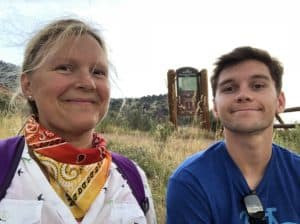
I was an army brat. I was born in Columbia, South Carolina, on the Fort Jackson army base. When I was just a couple months old, we moved to Germany. I was raised in the shadow of the Vietnam war. We lived in Germany until I was almost five, and then we moved back to the States. My dad was a recruiter, and his office was in downtown Raleigh, so we moved to Garner.
I grew up in Garner, went to college at UNC-Wilmington, and graduated from NC State. I always wanted to be a writer, a storyteller. I used to think that I wanted to be Jacques Cousteau. When I was at Wilmington, I was studying marine biology and English. Then I met a boy, fell in love, and transferred to NC State. NC State is landlocked, so there’s no marine biology there. I graduated with a degree in English.
During my last semester of college, I worked for McGraw Hill publishers as a copy stylist. I’m a graphic artist, a photographer, and a writer. And I’ve always used all of those skills in any job that I’ve ever had. My first job after graduation was in advertising, but I was only there for about a year. It was a small company, where short of death, there was no advancement potential. So I got a job at Nortel when I was five months pregnant. I started telecommuting, which was great. Peyton was born when my husband and I both worked for Nortel.
I was caught up in global corporate layoffs in the new part of the millennium and went into the nonprofit world. I started writing grants for an organization that helped women who were coming out of incarceration, living with HIV, and dealing with substance abuse and mental health issues. I did that for about a year or so and then left to go into the creative world of Theater In The Park as the marketing director. But Peyton was in elementary school at the time, and I would often be at work until one o’clock in the morning, and then you have to go back the next day. It was just crazy busy. That sent me further into the creative world. I started working as a freelance photographer and writer for a couple of different newspapers. I always maintain life as a storyteller. My last full-time job was as the Director of Public Affairs and Grants Administration for an HIV organization. We would lobby the general assembly for funding for HIV education and prevention.
Dolly, how did you get into writing romance novels and children’s books?
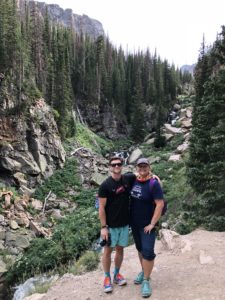
When I was growing up, we would go to the library on Saturdays, and my mom would get a bag full of romance books. I always would bad-mouth her because I was an English major and a writer. But then there was the time that we were snowed in, and I had read everything in the house. I was desperate for more books to read, so I unwrapped my mom’s birthday gift, which was a batch of romance books. I read all of them and thought, “Hey, these are really good!”
So I started to write romance books. I sold my first two books when I was still at the Alliance AIDS Services – Carolina, when my otherwise optimistic outlook was bogged down by sad, distressing epidemiological statistics. Then I decided it was time to make a change. My husband said, “Just do it quick — let’s take a leap of faith.” So we stopped eating out, stopped going to the movies…basically tightened the purse strings. That was ten years ago.
I had an accident seven-and-a-half years ago where I had a traumatic brain injury. In my recovery I had to learn how to read and write long-form fiction again. That’s when I started reviewing books, because it forced me to look at plot, character, and structure, and break it all down to help me build myself back up from a storyteller perspective. I would also look into the lives of other writers. I’m curious about what influences people, where they get their stories from, what’s their process, and how they write. I also teach three classes at the Wake Technical and Central Carolina Community Colleges, including introduction to grant writing, writing romance, and writing for children. So that’s where I am today. I write romance books. I write children’s books. I’m a book reviewer. I’ve written for USA Today and Doubleday book club. I’m an adjunct writing professor.
Dolly, tell me about your writing process.
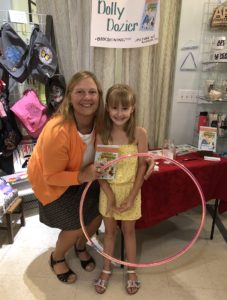
One of the things I learned is that writing a book, whether it’s a romance or a children’s book, it’s the same process, for any audience, any length, or any subject. You have plot, characters, theme, story — you have all elements of fiction, right? If you’re going to have a story, it’s got to have all those things. In terms of romance books, people will say to me, “Oh, it’s just romance. It’s a formula, right?” Well, no, it’s not. If it was, then you would have written one too, right? One of the keys to good children’s literature is that while there’s a lesson for children to learn, young readers need to be able to solve the problem on their own. They don’t need or require the adults in their lives to fix the problem for them.
My first children’s book is called Peggy Noodle, Hula Hoop Queen. It was set in the 1950s. I set it in the fifties because I’m always fascinated by stories from when my mom was a little girl. I wanted to tell a story of a little girl who was the outsider, the new kid in town, because I’m an army brat. Military kids are very resilient because they’re required to change all the time and adapt. I also was interested in telling a story about peer pressure. I wrote Peggy Noodle while I was working for the AAS-C and I was meeting all these people who were on this different trajectory in their lives. I wondered how their lives would have been different if they’d had a really solid childhood, with good support from their parents, good support from their friends, and self-confidence. Peggy Noodle is really about finding something that you’re good at, doing it well, and being comfortable in that. It’s important for young readers to read about characters who look like them and who experience many of the things that they go through.
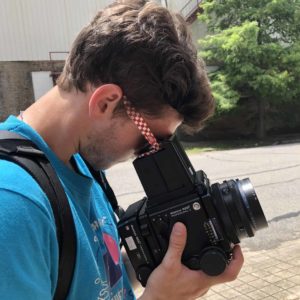
Peyton, over to you. Tell me about yourself.
Mine’s not as extravagant as my mom’s. We started donating a little bit to WUNC, which is an NPR affiliate, when I was in eighth grade, and since then we’ve maintained a steady involvement with the station. One day I got word of a youth radio internship series that they were doing. They were one of three stations across the nation that were doing that at the time. The first year I applied, I did not get it because I was too young, so I tried again the next year when I was a junior in high school and got in. I worked on a story about the new skate park in Apex, and how it bridged the divide between the skaters, the community, and the police. Two of the people highlighted in the story went on to receive the vice-presidential medal for the Heroes of Change program. After that, I decided I really wanted to give a voice to people who didn’t have one. I believe everyone has a story. When I was a sophomore at UNC-Greensboro, I realized I needed a distraction. So I picked up a camera that I didn’t realize I had packed with me that year, left my room, and went out to start shooting photos. Then I didn’t really stop. I just kept doing that every day. Then eventually some friends started shooting with me. We were all night owls, so we would stay out all night. We would constantly practice, just going nonstop, not really taking a break, just figuring out what works and what doesn’t work. That continued for a couple of months. Then during my junior year, I realized I just wasn’t really into school at that point. I wanted to get a degree but it wasn’t really for me at that time. But I was shooting enough that I wound up getting some work as a photographer. Then the National Geographic thing happened. Our family went on a trip to Hawaii during my sophomore year, and I took a couple of photos of kids at a building with an outdoor pool several stories overhead, not really thinking about it. The kids in the pool were just really excited and waving. I just wanted to capture that moment. I only took two shots of it. I always force myself to be able to get a shot within three shots. But for that wide shot, I only took two shots of it.

Like most other things that I’ve run into just by happenstance, the National Geographic Traveler of the Year competition popped up, I think on Instagram, so I thought I’d submit and see what happens. Then I totally forgot about it for months. Then out of the blue one day, my name started popping up online on MSN, Yahoo, The Guardian . . . everywhere, you name it. It turns out that the shot I submitted was part of the packet for the first week’s selection of finalist potentials for the competition. Because we were in that first week, we ended up being a part of their big promotional material. As I was looking through all the reactions that people were having of this one shot, I was realizing how much one photo can make people think. So I figured I’d maybe try and wing it and go for it as a photographer. Even though I didn’t win, I wound up as one of the ten finalists.
Within the first couple of months, a friend hired me to do some work. I also started working part-time at a camera shop in Carrboro. I was teaching myself about film and how to develop it, and over time, I became what they consider a film specialist. I can develop every type of film in every format–color, b&w and slide. I do it at home because I rebuilt the entire garage so I can handle the yield.
Peyton, how did you start working as a photojournalist?
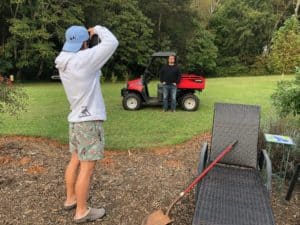
At some point last year, WUNC got word that I was taking photos and asked me if I would be interested in shooting Bernie Sanders. He was at UNC, and that was my first kind of coverage for WUNC at the time. That was also the start of my political coverage, where I had this whole season of shooting politicians, including Bernie Sanders, Joe Biden, and Amy Klobuchar. This summer has been dominated by protest coverage. Through all the stuff I’ve been doing, I’ve realized how much power a story can have. Photos are the same way. I’ll be capturing Election Day coverage on November 3 for WUNC. I’m looking forward to witnessing the election process of different people through this lens.
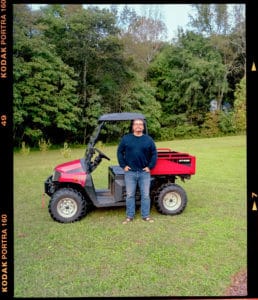 I have a friend who’s been bringing me along to some big shoots for the New York Times, Vanity Fair, and GQ. I’ve gotten to meet some pretty big names. But whether I have a local shoot for Chatham News & Record, or I have a Conde Nast shoot somewhere on the East coast, there’s no real difference. People are people. They’re subjects; they’re the shot. They’re proud, they’re awkward, they’re everything. I always find it fascinating.
I have a friend who’s been bringing me along to some big shoots for the New York Times, Vanity Fair, and GQ. I’ve gotten to meet some pretty big names. But whether I have a local shoot for Chatham News & Record, or I have a Conde Nast shoot somewhere on the East coast, there’s no real difference. People are people. They’re subjects; they’re the shot. They’re proud, they’re awkward, they’re everything. I always find it fascinating.
When I shot for GQ, we were shooting Bubba Wallace, the NASCAR driver. He’s goofy. He grew up in Concord, and my dad’s mom, my GrandPat, she loves him just because he grew up in Concord. To her, he’s cool just for that reason alone. I was really curious to meet him because I didn’t know much about him personally. It’s just been such a privilege in the year and a half I’ve been functioning as a full time photojournalist to meet these people and learn about the places they’re from and where they live. Because you know, everyone’s got a story.
Dolly, who inspires you?
I read everything. To begin with, my biggest influence was my mother. When I was a kid, she read nonstop. She had a nine-to-five job in downtown Raleigh, so she would get home at 6:30 each night. We both had jobs, plus a weekend job cleaning bank buildings at night. We were constantly busy when I was a kid. So on Saturday afternoons, my mother wanted to read. She would lay down on the couch to read, and you had to go over to her and physically touch her to get her attention. Books for my mother were always for escapism. It was a glimpse into another world, away from what she was doing. She also was a big library patron so I grew up seeing the library and books as a way to experience things that other people have done.
I also drew inspiration from the people I met through the nonprofit work I did, where I was working with clients in the Triangle-area living with HIV disease, and also battling other issues like homelessness and addiction and things like that. For many of them, there would be one event where they would get sick and would need to miss work. Then they go through all of their sick days. Then they lose their job and their house. These are just regular people who contracted HIV disease from one moment in time, one bad decision, or one dangerous situation. One mistake changes the trajectory of your life. It was my job to give those people a voice; to fight for those people who otherwise had no power and no voice.
Peyton, what about you? Who inspires you?
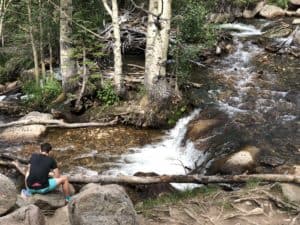
I gather inspiration from a lot of places. One of my largest influences is music. I always have some type of soundtrack in my head for a whole day. For the most part, depending on what I’m shooting or what I’m doing, I have music playing in my head if I don’t have it out loud.
But aside from music, there’s one photographer, Platon, who I can’t really get out of my head. He shoots with a Hasselblad, so it’s a 6×6 square format camera, and it’s film. Square is a hard format to work with, and seeing him excel at it makes it easier for me to share the space. He has this beautiful way of taking a square photo. He uses the frame in such a magnificent manner, typically with a wide angle lens, so it really fills the space. For certain images, he turns people into a huge towering presence.
 Peyton, tell me about your work at the Arts Incubator in Siler City.
Peyton, tell me about your work at the Arts Incubator in Siler City.
I’m planning to be there at least three or four months, so I’ve got a few different projects planned. One is a Latinx documentation project. I’ve been talking with the Hispanic Liaison at El Centro, and they’re helping me get a few people together to start off with who are comfortable having their photos taken. It’s all going to be for free for everyone involved. I want to get portraits of individuals, couples, families, kids, you name it; I want to get a visual basis of what the Siler City Latinx community looks like. Especially with the election coming up and politics in general, just as people of color are used as political vices to win elections, so are the members of the Latinx community. This in itself dehumanizes those in the marginalized categories of race and cultural affiliation which is extremely dangerous. My goal is to help form a better sense of empathy through a visual means. The Siler City Latinx community is not just a vote or a percentage; it’s a vast community of diverse and vibrant cultures.
I’m going to use this space and the time that I blocked out and force myself to go all in. I’m going to use this as a critical point in time to make sure that I’m capable of keeping up with the momentum I’ve slowly built over the last year and a half.
Last question. Dolly, in terms of the written word, and Peyton, in terms of the visual, what do you think is so compelling about storytelling? Dolly, let’s start with you.
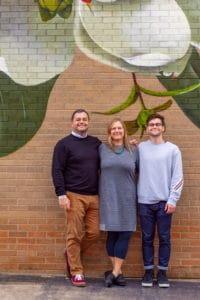
Every business has a tagline, and as a romance author, everybody has little taglines and things. Mine is, “Every story deserves a happy ending.” One of the things I discovered after leaving the corporate world was that I could really pay attention to people. I found that everybody does have a story to tell. And life is difficult for a lot of people. The happiest, wealthiest, most beautiful people in the world can have terrible situations. Just like the poorest and most downtrodden people can be super happy. You can never look at somebody and be able to tell what’s going on in their mind, what happened to them this morning, what’s going on in their lives. I always find it’s very important to just stop and ask questions. I’m discouraged when I ask people, women especially, “What do you do?” and they’ll say, “Oh, I’m just a stay-at-home mom.” You’re not just an anything. I think that people are lots of different things. When you can look at your world from that perspective, then you can have so many things that you do and that you contribute to the world. I’m a wife to a fabulous husband and partner. I’m a mom to the world’s best kid. I’m a writer, a storyteller, an advocate, a feminist, and an activist. And I don’t restrict myself to just one chapter. I’m 47, and I have had careers 3.0, 4.0, and 5.0. I grew up without a lot of money. My parents divorced when I was in middle school, so it was just me and my mother, and I always had wanderlust. One of the few things that my dad ever did for me was get me a subscription to National Geographic, and I probably kept that for 20 years. I always dreamed about far away places. I wanted to know what people on the other side of the world looked like and sounded like. What did they eat? What did they dream of?
I think all of the different things that are real obvious when you look at somebody face-to-face, next to you, where you can see all the superficial things that are different. To me, the most important thing is what bridges us and makes us the same. That commonality is something I’ve always strived for, you know, in my nonprofit work and just as a parent and as a woman. So that’s how I tell the story.
Peyton, what about you? What do you think is compelling about storytelling?
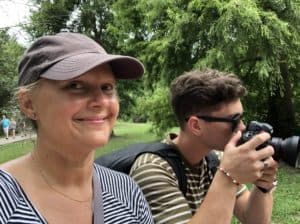
I share most of the same philosophy as my mom. But the biggest thing about photography is that no two people look at a photo in the same way. It’s very hard to understand everything that’s happened that led up to that moment. Storytelling is the oldest thing that we have as humans.
A photo is fast and easy to digest, even if it’s something dramatic or terrible, like an explosion. Being able to see that moment is helpful to people who can’t visualize it just by reading. Some people can read stuff and feel more than if they were to look at something. It goes both ways. A photo is a single moment in time.
Dolly: As you’re talking, Peyton, I’m realizing how we’re both storytellers. We’re both interested in making a connection and telling the story of people who may not have a voice otherwise, but you know, you use a photograph to tell the story, you encourage narrative around a photograph, whereas I take narrative and encourage a visual. I just never thought about it like that. That’s a really good way to put it.
For more information about Dolly and Peyton, visit them online through any of these links:
Peyton Sickles
Dolly Sickles

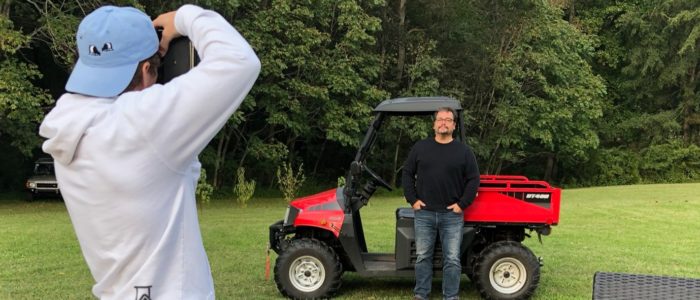
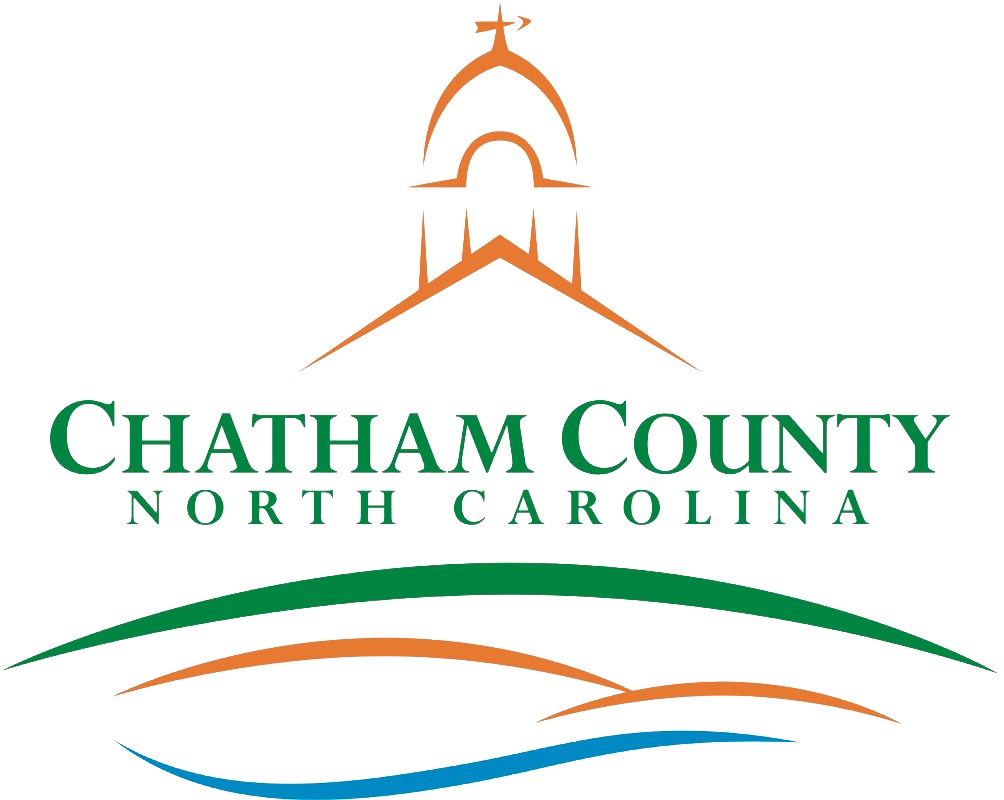

What an accomplished and confident family. Kudos!!